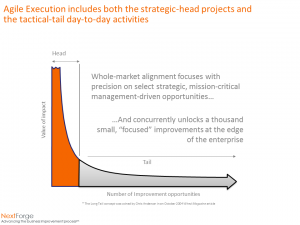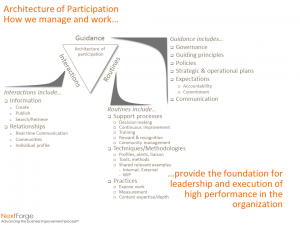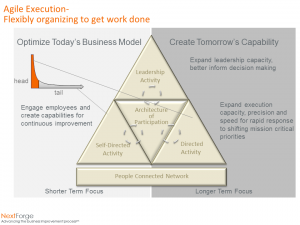“In the face of complexity and multiple competing demands, organizations simply can’t handle decision-making in a totally rational way. Not surprisingly, then, a single blunt instrument- like structure- is unlikely to prove the master tool that can change organizations with best effect”
This quote reflects our concerns on how to deal with the reality of extremely rapid change in the marketplace, accelerated by new and constantly innovating competitors. Just one probative slice of the modern enterprise reveals a prime example- the impact of digital marketing’s evolving technologies (see our iCitizen presentation). Today’s problems and competitive environment are different, and we must approach our go-to-market execution differently along all five dimensions which we collectively refer to as the Agile Execution Framework.
- Self-directed (day-to-day) Activity

- Directed (strategic project) Activity
- Leadership Activity
- Architecture of Participation
- People Connected Network
The work to be done- Tactical and Strategic Work of the Enterprise
 The way we accomplish both the day-to-day tasks and strategic projects of the enterprise must change- defining a new way of accomplishing the short-term and longer-term work of the enterprise. To illustrate, let’s make an analogy to Chris Anderson’s The Long Tail. The head, shown in orange on the left, represents the typically strategic projects, the capability-building, bet-the-ranch efforts. And, furthering the analogy, the long-tail embodies the individual effort of every employee as they go about doing their day-to-day activity of marketing, selling, fulfillment, post-sales service, and the like. We think of the large, strategic projects as Directed Activity– those efforts directed by leadership. Leadership directs these initiatives because they are mission-critical, they generally represent a significant risk to the enterprise, and often they build enterprise capability. A classic directed activity is a significant merger/acquisition. We refer to the day-to-day work as Self-directed Activity– those efforts self-directed by the individual. Self-directed effort represents an opportunity for continuous improvement at the most detailed level of execution. Processing a new order or taking a customer service call are characteristic self-directed activities involving an individual or very small group.
The way we accomplish both the day-to-day tasks and strategic projects of the enterprise must change- defining a new way of accomplishing the short-term and longer-term work of the enterprise. To illustrate, let’s make an analogy to Chris Anderson’s The Long Tail. The head, shown in orange on the left, represents the typically strategic projects, the capability-building, bet-the-ranch efforts. And, furthering the analogy, the long-tail embodies the individual effort of every employee as they go about doing their day-to-day activity of marketing, selling, fulfillment, post-sales service, and the like. We think of the large, strategic projects as Directed Activity– those efforts directed by leadership. Leadership directs these initiatives because they are mission-critical, they generally represent a significant risk to the enterprise, and often they build enterprise capability. A classic directed activity is a significant merger/acquisition. We refer to the day-to-day work as Self-directed Activity– those efforts self-directed by the individual. Self-directed effort represents an opportunity for continuous improvement at the most detailed level of execution. Processing a new order or taking a customer service call are characteristic self-directed activities involving an individual or very small group.
Increasing collaborative execution of directed and self-directed activity is a critical characteristic of agile execution. As collaborative execution increases and we get the self-directed activity right within a high-performance environment, we can begin to reduce the number and size of directed projects- as the thousands of small adjustments have reduced the need for as many major directed corrections. Less directed activity should allow leadership more time to lead.
Leadership Activity
In order to support the execution effort, both the directed and self-directed, enterprise leadership activity must change to create a collaborative and trusting environment. Leadership cannot delegate the behavioral change toward collaboration; it must demonstrate transparency, openness to ideas, and broader participation in direction setting. Leadership must: drive decisioning and accountability down into the organization, ensure supporting capabilities are in place, and reach out to the fringe of the enterprise for customer and market information. These and other “musts” will create a set of leadership activities aligned with the market and supporting execution. Creating this highly communicative and trusting enterprise does not happen overnight. Leadership must model aspirational behaviors, advocate for change, etc., all the while, maintaining focus on business outcomes and performance- delivering on two fronts (see What we have learned- so far).
 Architecture of Participation
Architecture of Participation
Today’s business environment has passed the inflection point where knowledge workers now lead industrial workers as the majority of our workforce. The way we work together, the way we knit together leadership activity, and self-directed and directed activity must change to follow suite. Our view of the necessary architecture of participation includes three primary dimensions including the guidance we establish and receive, our routines, and our interactions… all requiring change from the traditional norms of participation.
People Enabled Network
Providing a foundation for the modern enterprise is what MIT’s Professor McAfee refers to as the “emergent social software platforms”. We know them as Jive, SharePoint, SocialText, Moxie, Box, etc. Add in people, relationships, and the data available on one of these platforms and you have what we refer to as the People Connected Network. The platform’s easy to search, ask and share the right information with and from the right people, including subject matter experts, provides visibility to the links, connections and information to support today’s knowledge worker.
New skills
As we look into this new reality, there are a number of new roles and capabilities we feel will be necessary. A few key resource focus areas are highlighted in the following.
- Community management- A way of thinking, working and managing with others ranging from prescriptive to self-supporting; A way to organize people
- Content curation- A way to organize and grow information; A way to consolidate an over-abundance of data, ensuring the latest, vetted information is easily retrieved
- Individual execution acumen- A way to develop individuals for success in an agile environment exhibiting situational awareness, the ability to influence without formal authority, the ability to commit and deliver (accountable) business determined outcomes; A way to organize individual development
Putting It All Together
 Market-aligned agile execution with flexibility and responsiveness requires organizational capabilities and individual skills to work in a new way. It requires supporting durable capabilities necessary for social business success (see The 5i’s). Enterprise-level change starts with a change in leadership, and is generally best accomplished through an evolutionary approach- a blended mix of traditional and community-based structure inside the enterprise. And, as with all change, it begins with and is based on changing the behaviors of individuals.
Market-aligned agile execution with flexibility and responsiveness requires organizational capabilities and individual skills to work in a new way. It requires supporting durable capabilities necessary for social business success (see The 5i’s). Enterprise-level change starts with a change in leadership, and is generally best accomplished through an evolutionary approach- a blended mix of traditional and community-based structure inside the enterprise. And, as with all change, it begins with and is based on changing the behaviors of individuals.
Structure is not organization
Remember the opening quote? Where the author explores the idea of structure not meeting the single-tool test with all the increasing complexity? The quote is from a seminal work by Robert Waterman, Tom Peters, and Julien Phillips introducing their 7-S framework “for organizational thought” more than three decades ago (See Structure is not organization, Business Horizons, June 1980).
We are still working on getting it right, and it continues to be about more than structure. It is about how to organize.

